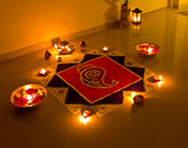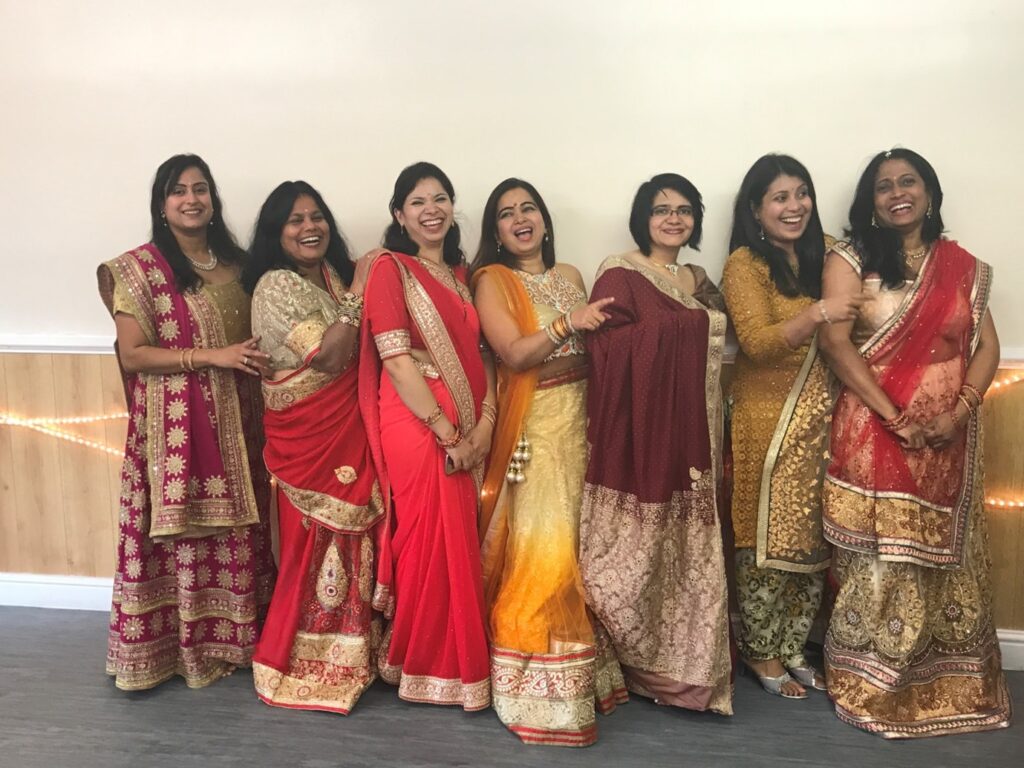
We would like to thank Dr Smita Tripathi for taking the time to put this article together.
What is Diwali?
Diwali (or Deepawali literally row of lights or deep) was celebrated on the 14th of November this year on a no moon day. The word comes from the sacred language of India called Sanskrit. During this festival, people decorate their homes with lights and oil lamps, called deep or diya, greet one another, distribute and exchange sweets and gifts.
In one of the traditions, Diwali honours the Hindu goddess of wealth, Lakshmi. The lights and lamps are said to help Lakshmi find her way into peoples’ homes, bringing fortune and prosperity in the year to come! Contrast this with other ancient societies, where wealth is associated with a male God, Plutus in Greek or Mercury in Roman traditions, it is a socio-cultural-religious festivity from the South Asian sub-continent celebrated variously by Hindus, Sikhs and Jains and is one of the most-looked-forward-to festivals like Christmas. It is in a true sense the festival of unity in diversity. It brings people together despite religious, cultural, social or geographical barriers.
Different parts of the sub-continent celebrate it variously; as manifested through the range of bhajans (devotional songs or hymns) and rituals, foods, cultures, performances, celebrations and even attire associated with it. It is celebrated in Mauritius, Nepal, Bali, along with other countries where Hindus, Jains or Sikhs reside. The diverse traditions and customs can be traced back to various regions and a varied heritage that has withstood the syncretism and evolutionary path of an ancient celebratory worship. A very rich cultural – religious mosaic of events and rituals marks the unique celebrations and events. It is truly a special joyous exuberant opportunity to rejoice as it marks the New Year, triumph of good over evil and the overtaking of darkness by light.
When is Diwali?
As per the Hindu calendar, Diwali is celebrated for five days with the focus on the no moon/new moon night in the month of Ashwin in the Hindu calendar. The exact dates change each year and are determined by the position of the moon – but it usually falls between October and November.
The first day of Diwali is Dhan Teras which is usually associated with buying a new object of domestic use which is usually made of metal.
The second day is called Narak Chaturdasi. On this day Lord Krishna destroyed the demon Narakasur and made the world free from fear. Another legend requires the lighting of 13 lamps for Yamadeva (or the God of Death like Hades in the Greek legend) – the belief is that lighting these lamps and praying will avert untimely death.
On the third day is the actual Diwali, when Lakshmi-Ganesha are worshipped. This duo are the Gods of wealth and auspicious beginnings. In some parts, Saraswati, the Goddess of Learning is also worshipped.
The fourth day is marked with worship of Lord Krishna (also called Govardhan Pooja) – the legend recalls that Krishna lifted Govardhana Hill to protect the inhabitants and cows of Vrindavan.
On the fifth day of the Diwali, Bhai Dooj is a celebration of the deep love between brothers and sisters. The day is celebrated by the sister applying a big tilak on the brother’s forehead and praying for their long and healthy life.
How do we celebrate Diwali?
Diwali is celebrated with enthusiasm and a range of traditions and customs. Everyone has their own traditions and ways of celebrating. Such traditions are passed on in families and new ways are added over time. Many customs and menus are borrowed and exchanged over the years, as we celebrate with our families, friends, communities.
In my home, along with a range of crisp and flaky sweets like sakar para, gujiya, longlata, we also had gulab jamuns and jalebi. Then there was a host of savoury food like namkeens, kachori and spicy lentil mathris. Platefuls of these were made and exchanged with relatives, neighbours and friends. On the sixth day of the new moon, the sun god Surya and his sister Chhatti Maiya are celebrated with ceremonies referred to as Chath Pooja. We children started the day with Surya Namaskaar and recital of Sanskrit and other hymns. In the evening, we had savoury samosas stuffed with green peas.

Earthenware or terracotta oil lamps are called diyas – and they took various intricate shapes, and were decorated in a variety of ways and colours. Rangoli is the art of making elaborate designs on the ground to decorate homes using colourful powders, lentils, flowers and the like. Rangoli or alpana (as these complex patterns are called) and diyas are used to make elaborate and colourful decorations on the threshold and entrances of homes. Again, a huge diversity of patterns and traditions exist in different regions and cultures.
For Jains (an ancient religion from India paralleling Buddhism in its antiquity), Diwali celebrates the anniversary of Lord Mahavir’s (527 BCE) attainment of moksha, or freedom from the cycle of reincarnation. Each year Jains light lamps to keep alive the light of Lord Mahavir’s knowledge and remember his contribution to humanity.
For Sikhs, Diwali is significant because it marks the release from prison of the sixth guru, Guru Hargobind Singhji along with 52 other princes in 17th Century AD. Sikhs celebrate by visiting the Gurudwara and remembering Guru Ji through prayer, meditation and charity.
My lived experience
Growing up in India, Diwali was always celebrated as a mix of traditions, truly embracing the diversity associated with this festival. Families tend to come together and honour different traditions and ways; going to Gurudwara, Hindu or Jain temples was common. Langar Prasad from the Gurudwara was a favourite memory. In the evening we prayed to Goddess Lakshmi, Sarasvati and Ganesh and lit lamps and firecrackers. Charitable acts were an inherent part of the festivities and food and gifts were given to those less fortunate as well as family and friends. The universal message of respect, generosity, peace and unity is at the heart of Diwali
As children we loved Diwali as it epitomised joyful celebration; it was about the energy and the excitement, sheer exuberance and fun with new clothes, visitors and visiting, a vast array of delicious food. The dark evenings took on a fairy-tale appearance with lamps lit and strings of lights twinkling. Cleaning the house and painting the walls and decluttering was a less enjoyable but nevertheless imporatnt part of the festivities. New kitchen or household goods were bought. The shops and the market places were truly colourful and extravagantly decorated, bursting with all kinds of treats and gifts. Going to the shops was a treat in itself – it felt like going to the fun fair. Food was cooked on a massive scale and was exchanged with friends and families.
Over the years, as the grey has descended in my hair, I have come to appreciate its spirituality and diversity ethos. It is about good food and nice clothes, but equally it is about sharing these. It is about celebrating the triumph of good over evil and what we as human beings can do to achieve this not only within ourselves but in our communities and societies. Every year Diwali is a testament and a celebration of the rich heritage that ties Hindus, Jains, Sikhs and the rest of humanity and Nature too. We appreciate the richness of pluralism and harmony in action – we celebrate it together with different faiths and communities coming together and yet celebrating it in unique ways. It enables us to embrace our rich heritage and tradition and brings it to the current time reminding us of the eternal relevance of celebrating truth, light, and goodness.
When I had first come to Plymouth in 2002, few people knew about this festival. Now I receive messages of celebration from my friends across all communities. Even though some of my neighbours had only vaguely heard about the festival, now more of them wish me well on the day. But the awareness and acceptance of our traditions has increased and continues to do so with each year. I hope more of my co-workers recognise our customs and actively choose to dress up in traditional attire and partake in the festivities.
Diwali is also a harvest festival that marked the last harvest of the year before winter. It is a celebration of life and things that grow. Popped grains are placed as offering and worshipped in gratitude. This relates to the significance of agriculture in the sub-continent. Another tradition is followed by accountants and those who deal with files and record keeping – they celebrate their tools, close their accounting books and pray for success at the outset of a new financial year.
The spiritual significance of this festival begins with a practical focus on cleaning and decluttering, getting rid of the baggage of the past and truly readying oneself for a pure new beginning. Reflecting, turning inwards and recharging ourselves with new energy is how we can overcome the darkness within and embrace light and positivity. Light is symbolic of knowledge or gyan and the rows of lights are marked by the dissipation of ignorance. Diwali suggests how negativity within or outside can be conquered by the inherent goodness and positive energies of an individual. Our minds are constantly inundated with all kinds of noises, emotions and externalities, bickering, arguing, and judging, and so on. The isolation and the economic – social ramifications during this pandemic has been huge; Diwali provides us with the space and time to overcome our challenges, emerge stronger and come together as human beings. As you prepare for new beginnings, I wish you all a year of reflection and celebrating light through knowledge. आत्म दीपो भव: or translated from the Sanskrit, be a light unto yourself. And may you light the path ahead…
Dr Smita Tripathi
(smita.tripathi@plymouth.ac.uk)

Our staff members in their traditional attire to celebrate Diwali
From left to right (Madhoo REI Doctor, Rupitha Traînée in ED now GP, Abha – Lab consultant previously in Derriford now in Torbay, Shagun in Research at University Plymouth, Nidhi wife of Dr Dubey oncologist, Shadna ENP ED, Rachna wife of Dr Purayil Radiologist consultant)

Smita Tripathi
Lecturer in Leadership and Human Resource Studies
Smita specialises in teaching leadership, human resource management, organisational change & performance, public sector management, diversity management, international business & strategic leadership and governance at undergraduate and post graduate levels. She joined Higher Education after a successful career as a Civil Servant in India. She has managed two Higher Education capacity building projects, one funded by ESF (2004-2008: £ 550,000 working with Further Education Colleges in the South West from Penzance to Bristol and Weymouth/Salisbury) and the other by HEFCE (2008-09: (£150,000 focussed on leadership and governance of HE provision in FE). In terms of research, her interests encompass debates, ambiguities and critical issues in leadership, governance, change and performance management and public sector management. Through her PhD, she has developed a dynamic ‘fluid fractal’ model of leadership that is processual, relational, shared and discursive.
She is secretary of the South Asian Society of Devon and Cornwall and has been involved in community, race and diversity issues through this and other charities in the South West since 2002.
Address: Room no 213, Cookworthy Building, Plymouth Business School, Faculty of Arts, Humanities and Business, University of Plymouth, Drake Circus, PL4 8AA. Tel. 01752 585843
Email: smita.tripathi@plymouth.ac.uk
